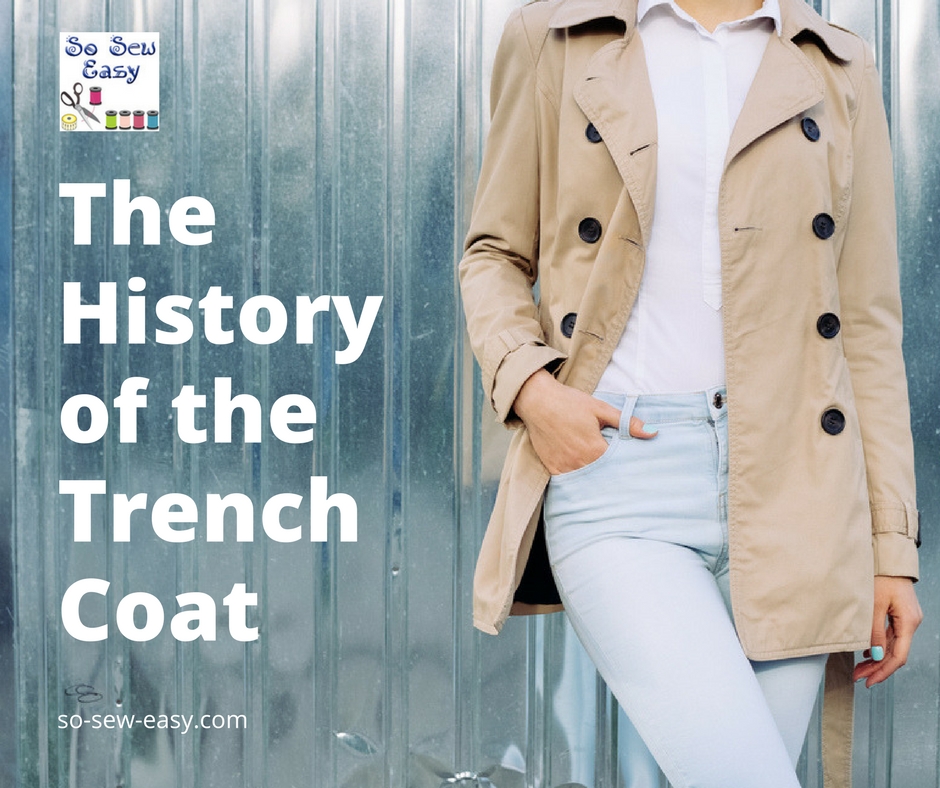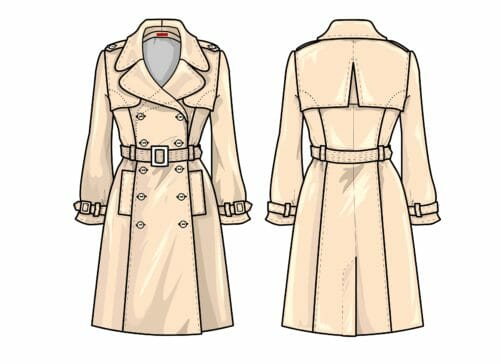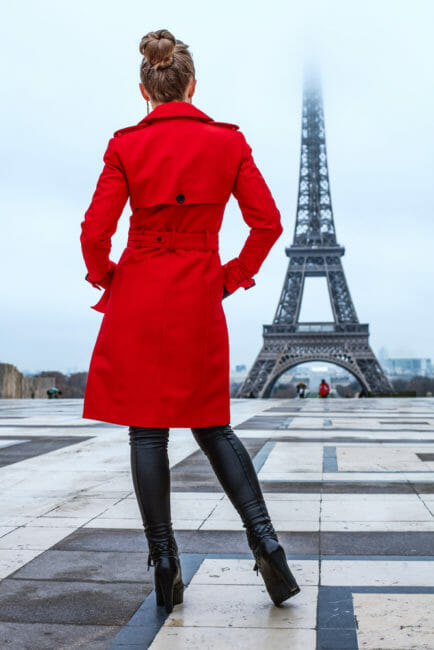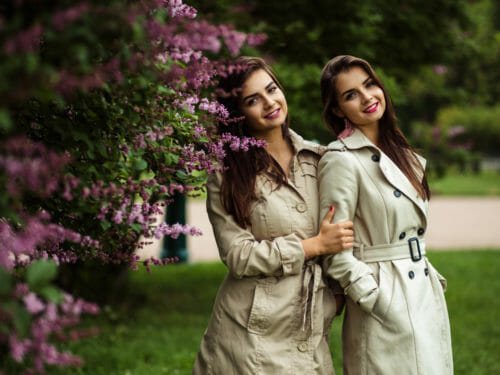
I've always wanted to do a project to sew my own trench coat. I've loved trench coats since I was a teen and with autumn just around the corner, I think it would be a fun project the would result in a practical garment for the cool, wet weather that is on the way. (Remember, I live in Chile in the southern hemisphere so the seasons are reversed. Even so, this makes a good project for spring if you're in the northern climes.)
As I often do before a project, I wanted to research the trench coat history so I could better understand how and why they were made. Below is what I learned. If you're interested in a pattern and project to sew your own trench coat, please let me know in the comments at the end of the article. If a lot of readers are interested, I'll get started on the pattern.
Trench Coat History
The iconic standard dress of detectives, spies, central park flashers, explorers and human-race-saving action heroes. Inspector Clouseau, Neo and Trinity, Sir Ernest Shackleton and the weirdo on the park bench all have one thing in common…the trench coat.
This staple of Western fashion culture is a favorite of men and women, young and old. A practical, waterproof item that can be pulled on over anything, whether it be sexy lingerie, a concealed magnum or Katana or a superhero leotard and stockings. The trench coat is here to stay, forever being revived and revitalized on runways and in the movies. Let’s take a closer look at the origins and characteristics of the humble (or is it not-so-humble?) trench coat.


Characteristics:
Typically seen with ten large (plastic or wooden) buttons, the double breasted trench coat is traditionally worn in camouflage military colors like Khaki, tan, beige and black but over the years it’s been manufactured and featured on runways in just about every color and print known to man.
The shoulder straps of the trench coat were added during WWI so that soldiers could attach their rank insignia and epaulets. D rings were also added so that map cases, swords, and other equipment could be attached. Coats also included huge pockets for storing gear and ventilation flaps for expelling dodgy wartime odors. The name ‘trench-coat’ was originated during the war, by front line soldiers who saw the officers wearing the coats on a daily basis in the trenches.
Trench coats were designed to be short enough not to trail in the mud and flaring out wide enough from the waist to allow freedom of movement. Small cape crosses at the back allow water to slough off efficiently. The original coats came with a removable liner that could double as a blanket when needed. Collar buttons at the neck would allow gas masks to be tucked under the collar so that they would be more airtight.
Trench coats usually have raglan sleeves, extending from the cuff all the way to the collar, so the seam runs from collarbone to underarm, but designs do vary. They also have cuff straps, to be fastened when spying with binoculars, so that water won’t run down the arm. They are meant to protect from wind and rain, not so much snow and cold. They are usually made from a thinner material than an overcoat or warmcoat, but their loose fit means that extra layers can be worn underneath. They were sized large so that British Officers could easily wear their warm coats underneath.


Origins:
Thomas Burberry came up with the idea for the trench coat after inventing a waterproof fabric named gabardine in 1879, the trench coat was designed by him as an Army officer’s raincoat or windbreaker, he delivered the plans to the United Kingdom War Office in 1901 and they accepted.
However, the UK based company, Aquascutum (inventors of a waterproof fabric by the same name), also lays claim to the invention, much earlier: in 1851, for officers serving in the Crimean War. Even before this, a similar rubberized cotton coat (a Mackintosh) was worn, the idea for the ventilation flaps originated from the terrible mixture of rubber smell and sweat which was a side effect of wearing the Mack.
So (after Burberry’s submission in 1901), the trench coat, as we recognize it, became available for British Officers and Warrant Officers 1st Class to order at will. The fact that the trench coat wasn’t available for anyone of lower rank went a long way to building up the reputation of the coat in perpetuity. To this day it’s considered a gentlemanly or ladylike staple for businessmen and people of class.


Back Home:
Officers grew attached to their coats and continued to wear them at home after the war, that’s how the trench-coat took to the streets. Another factor in their popularity was the fact that Burberry and Aquascutum while being the standard military outfitters, were also leading gentlemen’s wear and sportswear manufacturers.
A practical item for cold weather, waterproof with great big pockets, easy to pull over a suit or ballroom gown. Back at home, the belt would often be tied in a loose knot, instead of fastening the buckle in the more formal way done by military men.
When WWII began, the trench coat was still the best option for officers in the field during cold weather. Other countries followed suit but soon the coat became shorter and eventually, the shorter field jacket took over from the trench because it allowed officers to be a little more mobile. Nevertheless, back home on the streets, the fashion stuck and the trench coat had found a place in society.
It became quite obvious in the 1990’s that the real wartime origin of the trench coat had been forgotten…Burberry advertising campaigns on Regent Street read in huge letters ‘Trench Fever!’, only veterans of war remembered that trench fever was, in fact, a nasty disease that had been spread by lice in the trenches during the war.
Wartime, as well as mafia and detective films, made the trench coat something truly iconic, we’re all familiar with the ensemble of a trench coat, fedora, and cigar made famous by so many Hollywood movies. Over time, designers began downsizing the coats and making them out of warmer fabric, so the warm coat and the trench coat pretty much serve the same purpose these days.
Nowadays the trench coat makes its appearance on cue every winter in some format or another and most of us are able to say that we either plan to own one or we already do!










I had a trench coat for a short time a few years back. It was a fashion item, had no warmth factor at all. It was black.
I thought I would not buy one again but if I had a pattern that I could make to suit my needs I’d be interested. I would treat the features as fashion items, epaulettes, cape, buttons, belt.
This comment made me laugh because I have a trench coat as well, and indeed it is just a fashion statement except for the fact that when it rains The water falls off it, and the wind doesn’t penetrate my ribs so easily.
I had one as a teenager – Black – loved it. Not sure what happened to it, but as an adult, would love to have another. Being able to make my own would be a big plus!
I had a black trench coat for years – the pockets were inadequate and there was no removable warm lining. I don’t know what happened to it. There is a chance it is buried in one of the closets. I would like to make one for myself, with a removable, warm lining. The weather seems so unpredictable these days, that it might work for most of the year.
These types of coats are hard to find and expensive these days. Worth trying to find it and replicate the pattern.
I loved my trench coat years ago and have had difficulty finding a good one since. The ones made for women seem to forget the important flaps over the shoulders and the flared skirt, not to mention the adjustable sleeve straps. Haven’t been able to find a good trench pattern for decades, either, so I would love to see a real trench coat pattern suitable for women. I thought of trying to adapt an existing safari coat pattern, but haven’t gotten the energy and drive up for the task, yet.
Hi Linda, I will keep your request in mind, sewing a real trench coat takes many hours of writing shooting the right photos around 16 hours of work and video editing (72 hours) that I hope one day I have the drive to accomplish since the pattern is already done.
Enjoyed the history lesson — thanks.
My pleasure!
I also like your and Deb’s patterns and their associated stories.
Yes, I’ll try making one. Please size the pattern to cover us all.
Yes please, I would love a pattern for a trench coat. I have made quite a number of clothes, both for myself and my children (now adults), but I have never ventured to a trench coat. I have a very old pattern of a similar coat that my grandmother (a trained dressmaker & tailor) made for my mother, but it looks a bit complicated.
It’s Amazing
Bundle of thanks for sharing
Thank you for the trench coat story. Please add me to the list.
Yes please. Up to XXXL at least.
very interesting, and I would love the pattern! Thanks
Yes! I want one also please. Great history lesson, thank you!
Thank you for the history lesson! And yes please,I would love a trenchcoat pattern!
Loved, loved, loved this read. Yes to the pattern. I own three and have been wanting to make one on my own.
Yes please!
Thank you very much for the interesting history of the trench coat. Yes please on a pattern.
Thanks for the Trenchcoat story, I never realized the coat had so much history.
I’ll throw in my YES! vote along with the others. Loved the hihstory lesson! Thanks!
YEAH! YES! PLEASE ADD ME TO THE LIST!
Really enjoyed the history and would appreciate a trench coat pattern as well! Thank you!!
fascinating history and would love a do-able pattern, go for it.
Yes, please! I would love to make a trench coat like the one pictured in red to brighten up the rainy days! Or maybe turquoise… or fuchsia? Yum!
Yes, I would love a pattern for the Trench Coat.
I too enjoyed your article and would also like a pattern for a trench coat.
I would like a pattern for a trench coat also!!!
Love history of fashion. Would like a pattern and fabric ideas. I have Bengaline and would like to know if it is suitable or is it too strechy. Greetings from South Africa
A trench coat with raglan sleeves? Yes, please! Raglan sleeves offer great movement!!!